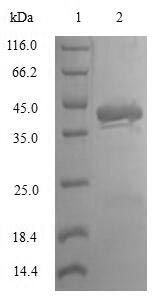The region for expressing recombinant Human TAC1 contains amino acids 1-129. This TAC1 protein is expected to have a theoretical molecular weight of 42 kDa. This protein is generated in a e.coli-based system. The TAC1 coding gene included the N-terminal GST tag, which simplifies the detection and purification processes of the recombinant TAC1 protein in following stages of expression and purification.
Protachykinin-1 is the precursor for tachykinin-1 (TAC1), a neuropeptide involved in various physiological processes, including neurotransmission, inflammation, and pain perception. TAC1 is predominantly expressed in the central and peripheral nervous systems. Substance P, produced by the proteolytic cleavage of the TAC1 precursor, acts as a neurotransmitter and neuromodulator, playing a role in nociception, mood regulation, and immune responses. The research on TAC1 spans multiple areas, including neuroscience, pain biology, and immunology, as dysregulation of substance P signaling has been implicated in conditions such as chronic pain, neuroinflammation, and mood disorders. Understanding the function and regulation of TAC1 and substance P contributes to the development of therapeutic strategies targeting these systems for various clinical applications.






